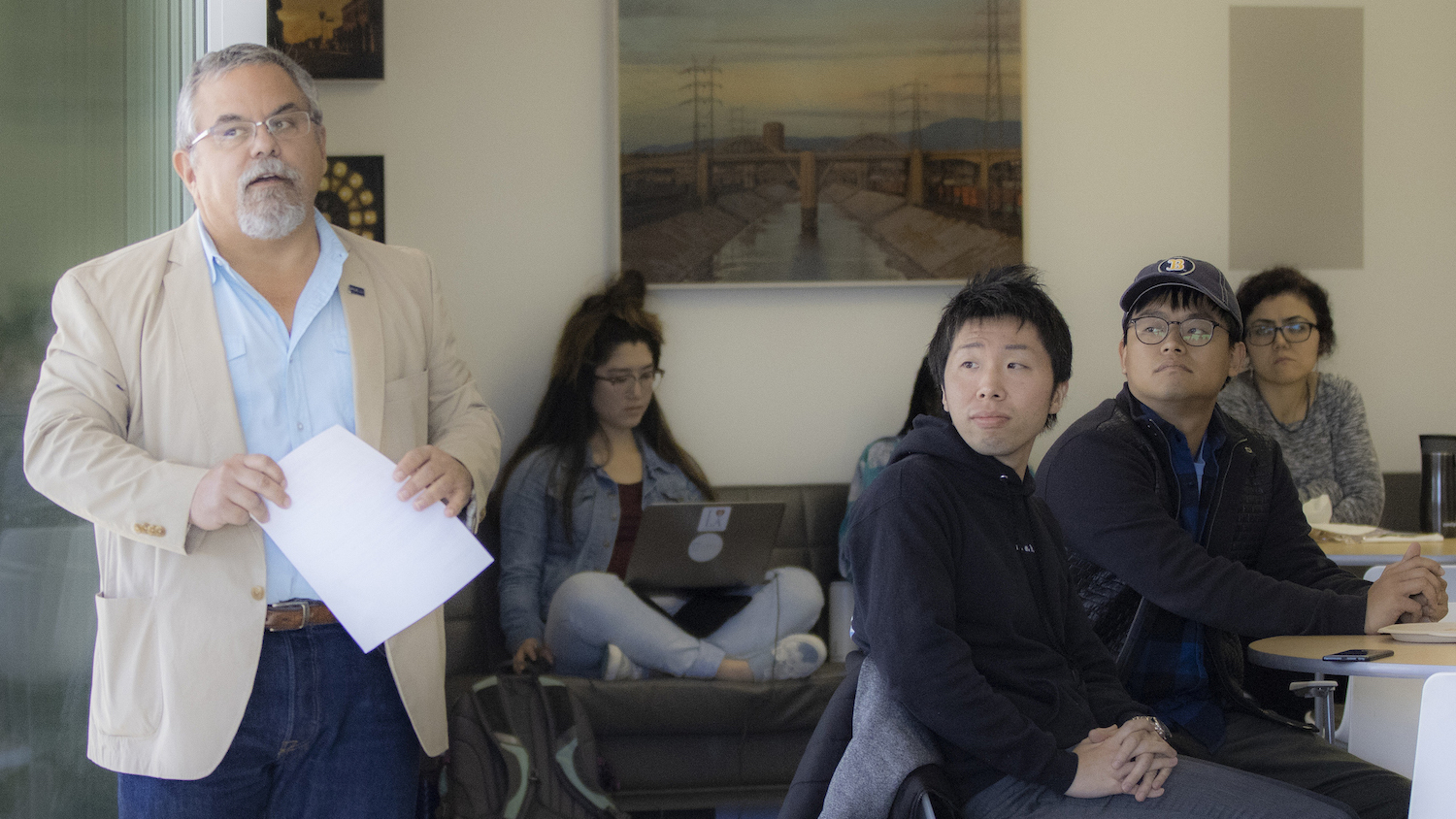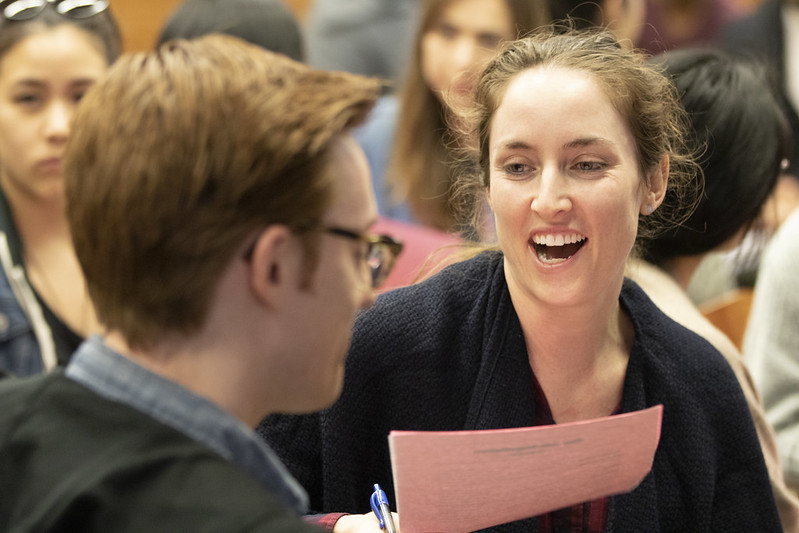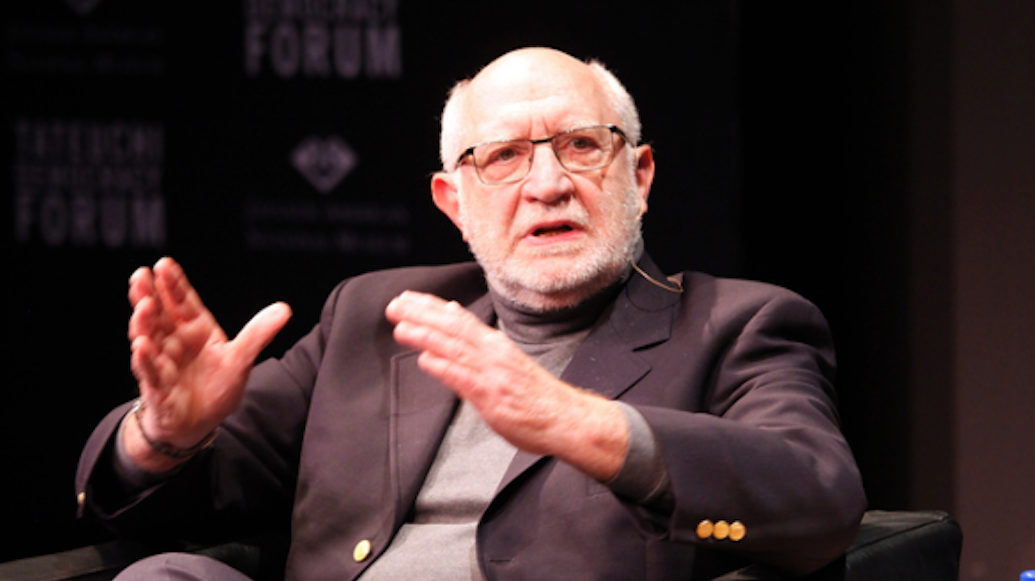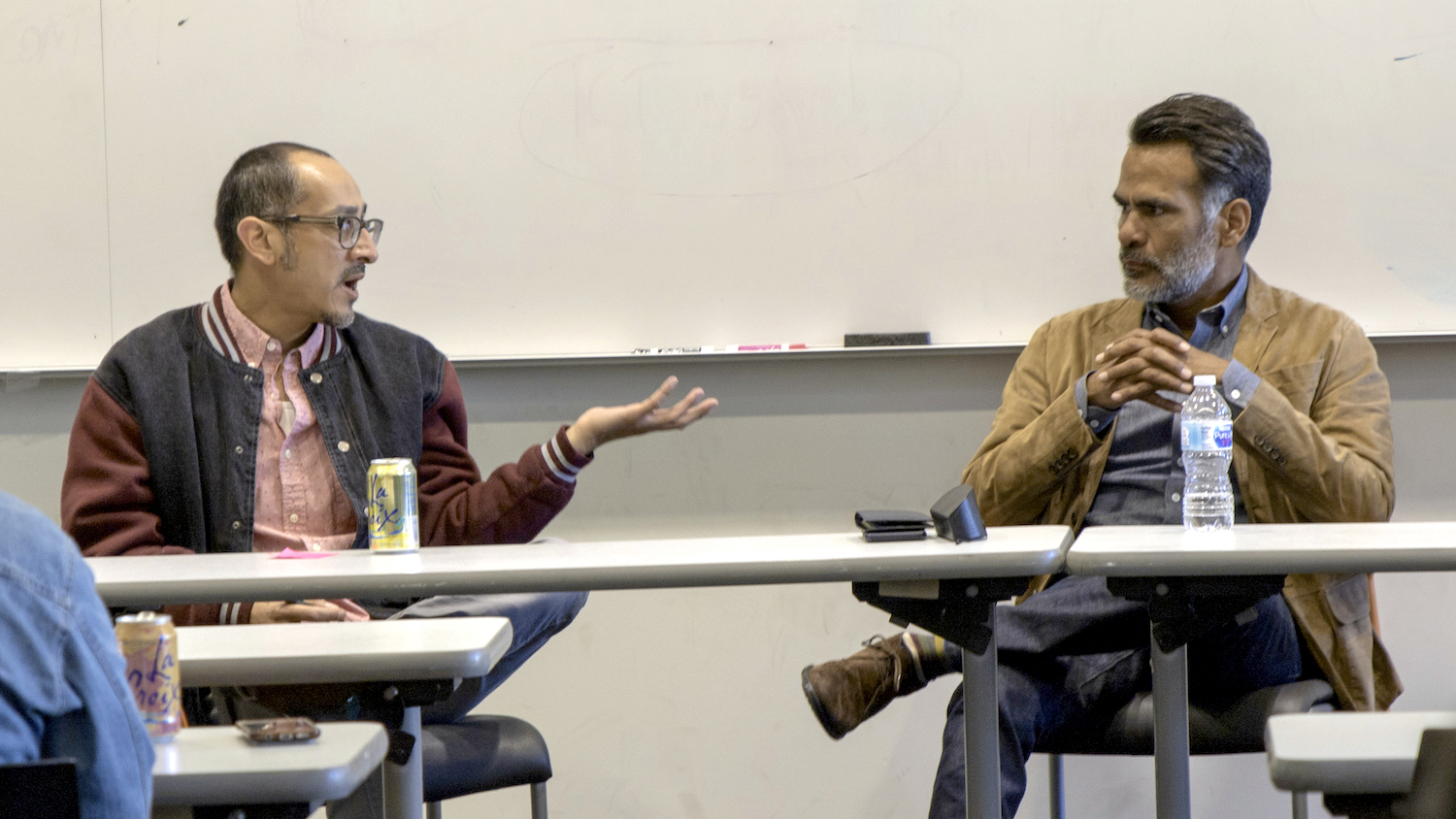
Forum Explores Latin American Identity of Los Angeles
Author and journalist Daniel Hernandez and professor Eric Avila explored the Latin history, features and identity of Los Angeles at a March 14, 2019, forum hosted by the Latin American Cities Initiative at UCLA Luskin. Initiative director Paavo Monkkonen, an associate professor of urban planning and public policy, moderated the forum on “Los Angeles as a Latin American City.” Hernandez, editor and host of L.A. Taco and the author of “Down & Delirious in Mexico City,” commented on corruption and infrastructure in Los Angeles, explaining that “there are things from Latin America that we should not import, [such as] the way political offices are doled out.” He noted that Los Angeles “is developing in a way that only benefits the people who already have money,” a pattern that is all too familiar in Latin American cities like Buenos Aires, Argentina. Avila, professor of Chicano studies and urban planning, researches the intersection of racial identity, urban space and cultural representation in 20th century America. According to Avila, Los Angeles is a Latin American city “in terms of population, the built environment, present-day demography, and the regional design and infrastructure.” However, he said, “Los Angeles is not a Latin American city in regard to the historically sustained efforts to whitewash and erase Spanish and Mexican past, including informal and formal practices of racial segregation, the creation of a subordinate labor force, racial hierarchies and white supremacy as a principle of urban development.” — Zoe Day
Town Hall Gives Graduate Students a Forum for Dialogue
Dean Gary Segura and key members of the UCLA Luskin leadership team fielded questions from graduate students at an informal Town Hall on March 14, 2019. Joining Segura and his staff were Public Policy chair JR DeShazo, Social Welfare chair Laura Abrams, Urban Planning professor Chris Tilly and Undergraduate Affairs chair Meredith Phillips. Students submitted questions in advance and from the floor, and the dialogue touched on diversity in admissions and hiring, space issues in the Public Affairs building, teaching assistantships and other financial support, and opportunities to connect UCLA Luskin graduate and undergraduate students, among other topics. As the Town Hall coincided with Pi Day, members of the Association of Masters of Public Policy Students served pie to those present. A separate Town Hall for undergraduate students is planned for the spring quarter.
View a Flickr album of images from the Town Hall.
UCLA Luskin Again Ranks High Among U.S. Graduate Programs
The UCLA Luskin School of Public Affairs is once again among the top 15 public affairs schools in the nation as ranked by the latest U.S. News and World Report ratings released March 12, 2019. The School retained the No. 14 (tied) spot in the ratings while moving up to No. 13 (tied) in the social work category. “I am extremely pleased that Social Welfare at UCLA Luskin has moved up in rankings to 13 in the nation as rated by our esteemed peers,” said Laura Abrams, professor of social welfare and chair. “We will continue to work to educate the most-prepared social workers at all levels of practice in our pursuit of equity and social justice.” The School — with graduate departments in Public Policy, Social Welfare and Urban Planning, and a new undergraduate major in Public Affairs — also received high marks for subcategories that include health policy and management (No. 12) and urban policy (No. 9). A number of UCLA professional schools and programs also were named among top schools in U.S. News and World Report’s “Best Graduate Schools 2020” guidebook, which will be available in the spring. According to the publication, yearly graduate program rankings are based on experts’ opinions about program excellence and on statistical indicators that measure the quality of a school’s faculty, research and students. Research for the publication included surveys conducted in fall 2018 and early 2019 of more than 2,000 graduate programs and more than 22,000 academics and professionals in the disciplines.
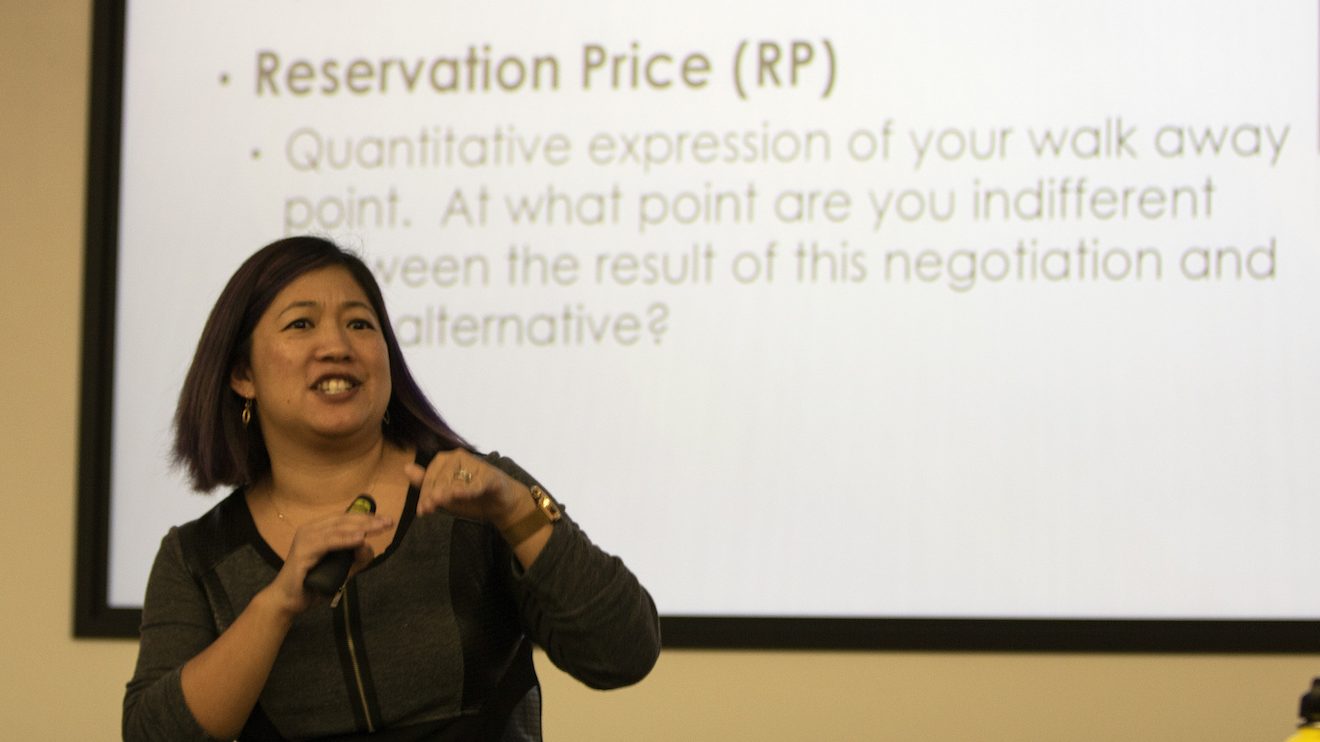
Workshop Teaches Real-World Skills in Job and Salary Negotiation
Public policy lecturer Kimberly Ling Murtaugh explained the ins and outs of job and salary negotiation at a workshop conducted in the Charles E. Young Research Library on March 7, 2019. The workshop was sponsored by Luskin Career Services, which promotes career readiness and prepares graduate students for employment. The workshop attracted students from all three UCLA Luskin graduate programs, including many second-year students preparing to enter the workforce after they graduate in the spring. Ling Murtaugh explained the essentials of negotiation analysis in three steps. First, job candidates can determine how much power they have in a negotiation by identifying their best alternatives to a negotiated agreement (BATNA) — a strong grasp of their options if the negotiation fails. Next, job candidates should identify their “reservation price,” the point at which they walk away. The last step is identifying a target, which Ling Murtaugh defined as a “realistically optimistic deal that will take care of your wants.” She recommended making a checklist of needs and wants to decide what kind of a salary is acceptable. “Negotiations are just another problem to be solved,” she said. “Tackle [negotiation] the same way you would another problem in the classroom.” While salary negotiation can be daunting, Ling Murtaugh explained that coming out of school is one of the best times to negotiate a jump in salary. She recommended preparing for negotiation by practicing with family members, friends or classmates. “Know your worth,” Ling Murtaugh told the graduate students. “Candidates have sources of power that they often forget.” — Zoe Day
View photos from the workshop on Flickr.

UCLA Sponsors Symposium on Universal Health Care
UCLA hosted experts in health care and policy at the E. Richard Brown Symposium on universal health care in California. Faculty with joint appointments at UCLA Luskin contributed to the symposium through workshops and presentations. The March 1-2, 2019, event honored the legacy of E. Richard Brown, a UCLA professor and public health leader who advocated for health care reform. The UCLA Center for Health Policy Research, founded by Brown in 1994, celebrated its 25th anniversary with the symposium. The first day of the conference, which can be accessed via webcast, took place in Sacramento and focused on planning, policy and political perspectives. UCLA professor of health policy and management Gerald Kominski gave a presentation on the contributions to coverage policies made by the Center for Health Policy Research. UCLA hosted the second day of the conference, including a workshop on the successful implementation of universal health care systems in Taiwan, Canada and other middle-income countries. UCLA professor of health policy and management Thomas Rice spoke about realizing Brown’s wish for universal health care. The symposium also featured UCLA professor of public policy Mark Peterson and professor of health policy and management and public policy Jack Needleman. Joseph Kutzin of the World Health Organization summarized the importance of universal health care: “Everyone should be able to have access to good-quality health services, without fear of the financial consequences for themselves, their families, their businesses and their jobs.”
Reality Check for Newsom’s Housing Crisis Plan
A new UCLA report casts doubt on the feasibility of Gov. Gavin Newsom’s campaign promise to address California’s housing affordability crisis by building 3.5 million new homes by 2025. The policy brief from the UCLA Lewis Center for Regional Policy Studies shows that cities and counties have the capacity to construct just 2.8 million new housing units. The report adds that “historically, only a fraction of planned units are actually built” due to limited demand, community opposition and other factors. The report also found that “much of the planned capacity is located in the relatively lower-demand, more rural parts of the state. … High-demand communities do not plan for or permit housing, and planned capacity in low-demand areas remains unbuilt.” The brief, titled “Not Nearly Enough: California Lacks Capacity to Meet Lofty Housing Goals,” is based on research conducted by Paavo Monkkonen, associate professor of urban planning at the UCLA Luskin School of Public Affairs, and Spike Friedman, an urban planning master’s student. Monkkonen is senior fellow for housing policy at the Lewis Center. The researchers examined data from 525 municipalities and unincorporated areas, which are mandated to zone for sufficient new housing construction to accommodate population growth. The brief highlights the obstacles created by the state’s zoning policies and the difficulty Newsom will face in meeting his stated goal. With California’s current construction patterns averaging 80,000 new housing units per year, the governor’s plan would require a sevenfold increase in housing construction. — Zoe Day
